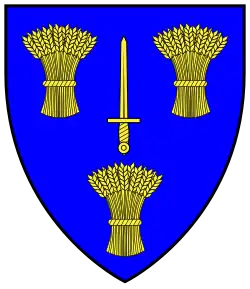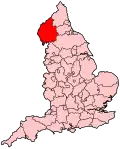Portal:Cheshire
|
The Cheshire Portal
WelcomeCheshire Plain from the Mid Cheshire Ridge
Cheshire is a ceremonial county in the North West of England. Chester is the county town, and formerly gave its name to the county. The largest town is Warrington, and other major towns include Congleton, Crewe, Ellesmere Port, Macclesfield, Nantwich, Northwich, Runcorn, Sandbach, Widnes, Wilmslow and Winsford. The county is administered as four unitary authorities. Cheshire occupies a boulder clay plain (pictured) which separates the hills of North Wales from the Peak District of Derbyshire. The county covers an area of 2,343 km2 (905 sq mi), with a high point of 559 m (1,834 ft) elevation. The estimated population is a little over one million, 19th highest in England, with a population density of around 450 people per km2. The county was created in around 920, but the area has a long history of human occupation dating back to before the last Ice Age. Deva was a major Roman fort, and Cheshire played an important part in the Civil War. Predominantly rural, the county is historically famous for the production of Cheshire cheese, salt and silk. During the 19th century, towns in the north of the county were pioneers of the chemical industry, while Crewe became a major railway junction and engineering facility. Selected article
St Mary's Church, Astbury, is a grade-I-listed Anglican parish church in the village of Newbold Astbury. The existing church is Norman in origin, perhaps replacing a Saxon building on the site. The exterior dates from the 13th and 14th centuries, and all styles of English Gothic architecture are visible: Early English, Decorated, and Perpendicular. During the English Civil War, Sir William Brereton's Roundheads stabled their horses in the church. The interior was restored by George Gilbert Scott in the 19th century. Described as "one of the most exciting Cheshire churches," it has an unusual trapezoidal shape, with an exceptionally wide nave, broader than that of Chester Cathedral. The tower is separate from the body of the church, joined to it by a passage with a porch, and is built in millstone grit, a rare material in Cheshire churches. The interior contains a Norman round-headed archway, and has the largest collection of medieval fittings and furniture of any Cheshire church. A late-13th-century canopied tomb, two medieval memorials and more than fifty 17th-century gravestones survive in the churchyard. Selected image
Arley Hall, near Lymm, is the seat of Viscount Ashbrook. The original 15th-century timber-framed building was replaced in the 19th century by a brick hall, designed by Nantwich architect George Latham and modelled on various Elizabethan buildings. Credit: Pixie2000 (26 October 2006) In this month
1 August 1984: Lindow Man bog body discovered. 2 August 1957: Lovell Telescope took its first image. 3 August 1952: Pianist Martin Roscoe born in Halton. 4 August 1643: Attack on Nantwich by Royalists led by Lord Capell during the Civil War. 4–6 August 1896: Princess Louise visited Crewe Hall and opened bazaar in aid of Crewe Memorial Hospital. 6 August 2012: Astronomer Sir Bernard Lovell died in Swettenham. 8 August 1953: First (private) motor race at Oulton Park. 9 August 1886: Grosvenor Museum officially opened by the First Duke of Westminster. 10 August 1933: Acton swing bridge over the Weaver opened. 11 August 1642: Confrontation between Sir William Brereton and Royalist forces near Ravensmoor during the Civil War. 13 August 1277: Foundation stones of Vale Royal Abbey laid by Edward I (pictured) and Eleanor of Castile. 15 August 1538: Dissolution of Chester's three friaries. 23–26 August 1617: James I visited Chester, Nantwich and Utkinton Hall, and hunted in Delamere Forest. 24 August 1538: Warrant issued for the dissolution of Vale Royal Abbey. 27 August 1781: First recorded game of cricket in the county. 29 August 1940: An air raid destroyed around fifty houses in Crewe. Selected list
The 27 listed buildings in Runcorn rural area include three at Grade II* and 24 at Grade II. In contrast to the Runcorn urban area, the surrounding borough contains small villages – Clifton, Daresbury, Moore, Preston Brook and Preston on the Hill – which have experienced only limited population growth since the Industrial Revolution, and are still separated by farmland and woodland. The oldest listed structure is the ruin of Clifton Hall, built in 1565. The three Grade II* listed buildings are All Saints' Church, Daresbury (pictured), dating originally from the 16th century, and two 18th-century former mansion houses, Daresbury Hall and Moore Hall. Many of the structures are related to the network of canals in the area, with several canal bridges, including a swing bridge over the Manchester Ship Canal, a former warehouse, a tunnel entrance, a milepost and two air shafts, as well as a railway viaduct crossing the Weaver Navigation. Other listed buildings include a public house, a former school and a former sessions house, as well as several farmhouses and cottages. The most recent listed structure is a K6-type telephone kiosk dating from the 1930s. GeographyTop: Map of modern Cheshire showing urban areas (grey) and the major road network. Chester (red) is the county town, and Warrington has the greatest population. Towns with more than 10,000 inhabitants in 2011 are highlighted; the size of dot gives a rough indication of the relative population. Wales and the adjacent English counties are shown in capitals. Bottom: Relief map showing the major hills. The Mid Cheshire Ridge is a discontinuous ridge of low hills running north–south from Beacon Hill (north of Helsby Hill) to Bickerton Hill. Most other high ground falls within the Peak District in the east of the county. Shining Tor (559 metres), on the boundary with Derbyshire, forms the county's high point. Administration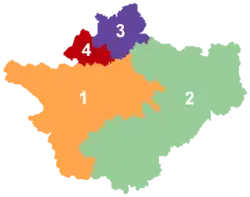 The ceremonial county of Cheshire is administered by four unitary authorities (click on the map for details): 2 – Cheshire East 3 – Warrington 4 – Halton In the local government reorganisation of 1974, Cheshire gained an area formerly in Lancashire including Widnes and Warrington. The county lost Tintwistle to Derbyshire, part of the Wirral Peninsula to Merseyside, and a northern area including Stockport, Altrincham, Sale, Hyde, Dukinfield and Stalybridge to Greater Manchester. Selected biography
Sir James Chadwick (20 October 1891 – 24 July 1974) was an English physicist who was awarded the Nobel Prize in Physics for his 1932 discovery of the neutron. He later measured its mass. Born in Bollington, he studied at the University of Manchester. His early research, under Hans Geiger, showed that beta radiation produces a continuous electromagnetic spectrum. He was Assistant Director, under Ernest Rutherford, of the University of Cambridge's Cavendish Laboratory for over a decade, when it was one of the world's foremost centres for physics research. In 1935, Chadwick joined the University of Liverpool, turning its physics laboratory into an important nuclear physics research centre by installing a cyclotron. During the Second World War, he was involved in the Tube Alloys project to build an atomic bomb, and later led the British team working on the Manhattan Project. Knighted in 1945, he served as Master of Gonville and Caius College, Cambridge 1948–1958. Did you know...
Selected town or village
Poynton is a town on the easternmost edge of the Cheshire Plain, near Macclesfield and Stockport. The manor was first recorded in 1289. The town straddles the Red Rock Fault, which brings the Permo–Triassic sandstones and mudstones of the Cheshire Plain up against the Millstone Grit and shales of the Peak District. To the immediate east of the fault are the coal measures of the Carboniferous period. Coal was mined at Poynton from the 16th century, and its collieries were the largest in Cheshire. Anson Engine Museum, on the site of a former colliery, has a collection of stationary engines. Consequent urbanisation and socioeconomic development necessitated better transport links; these came with the completion of the Macclesfield Canal through the town in 1831, and the arrival of the Manchester and Birmingham Railway in 1845 and the Macclesfield, Bollington and Marple Railway in 1869. The collieries closed in 1935. The population has nearly trebled since 1945, to over 14,000 in 2011. In the late 20th century, Poynton became a commuter town for Manchester. In the newsCrewe Market Hall 29 October, 1 November: Warrington council and the mayor of Crewe each announce plans to bid for city status in 2022. 13–14 October: Prince Edward visits Chester and opens a Fire Service training centre in Winsford. 8 October: Castle Street shopping area in Macclesfield reopens after refurbishment. 4 October: Restoration of the grade-I-listed Bridgegate, part of Chester city walls, is completed. 25 September: A bronze frieze by the sculptor Tom Murphy is unveiled in Warrington, as a memorial to the band Viola Beach. 9 September: The fifth stage of the Tour of Britain cycle race takes place in Cheshire, starting at Alderley Park and finishing in Warrington. 24 July: The grade-II-listed Crewe Market Hall (pictured) formally reopens after refurbishment. 15 July: Crewe, Runcorn and Warrington are awarded potential funding under the "Town Deal" government scheme. QuotationThey left the shimmering road for the green wood, and The Wizard was soon lost behind them as they walked among fir and pine, oak, ash, and silver birch, along tracks through bracken, and across sleek hummocks of grass. There was no end to the peace and beauty. And then, abruptly, they came upon a stretch of rock and sand from which the heat vibrated as if from an oven. To the north, the Cheshire plain spread before them like a green and yellow patchwork quilt dotted with toy farms and houses. Here the Edge dropped steeply for several hundred feet, while away to their right the country rose in folds and wrinkles until it joined the bulk of the Pennines, which loomed eight miles away through the haze. From The Weirdstone of Brisingamen by Alan Garner (1960)
Subcategories
TopicsRecommended articles.svg.png) Things you can do
WikiProject WikiProject Cheshire There are 3,619 articles in the project's scope Related WikiProjects UK Geography • England Greater Manchester • Lancashire and Cumbria • Merseyside • YorkshireRelated portalsAssociated WikimediaThe following Wikimedia Foundation sister projects provide more on this subject:
Discover Wikipedia using portals
|

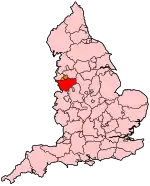

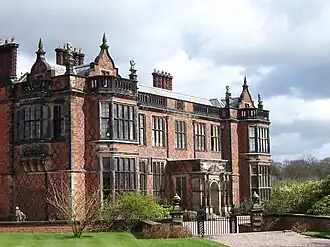
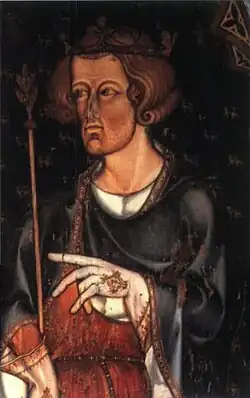
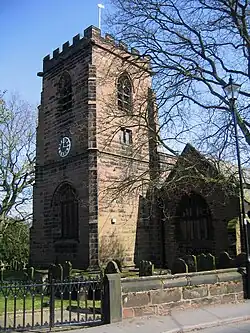
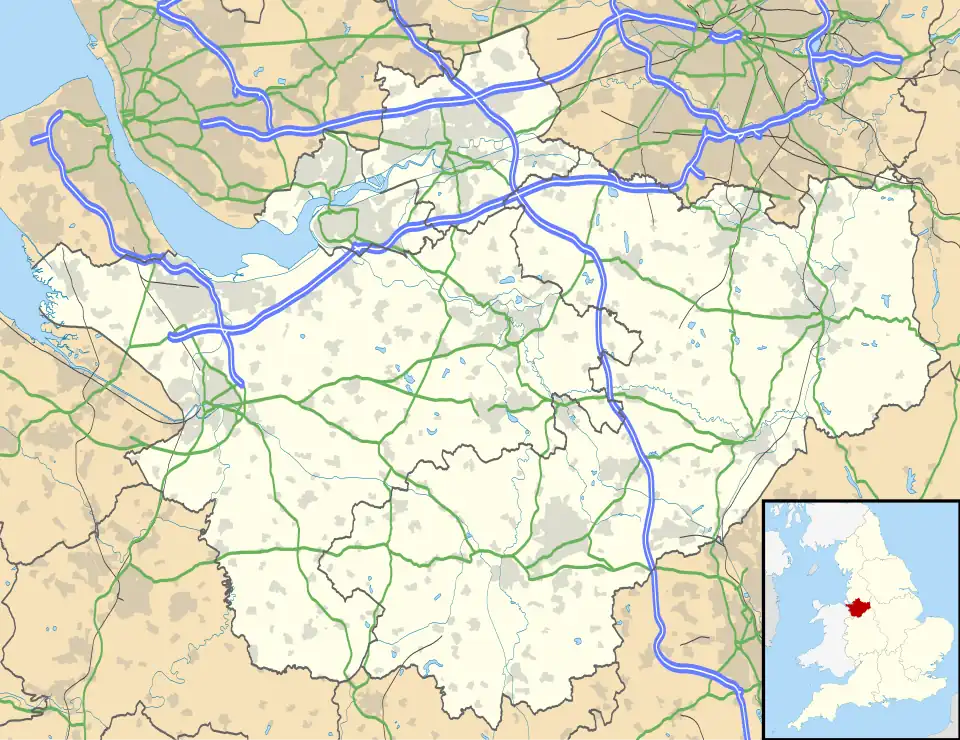
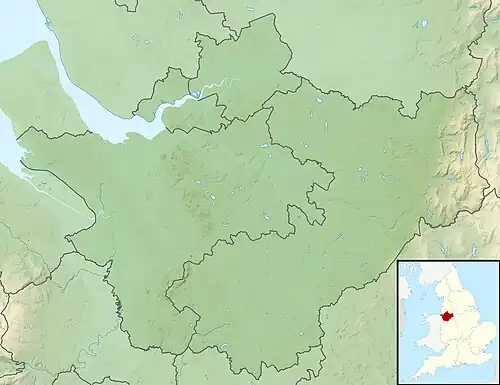
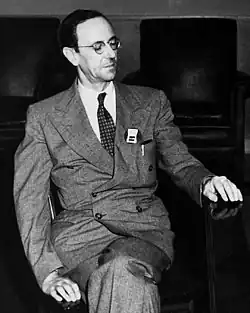
_1.jpg)
